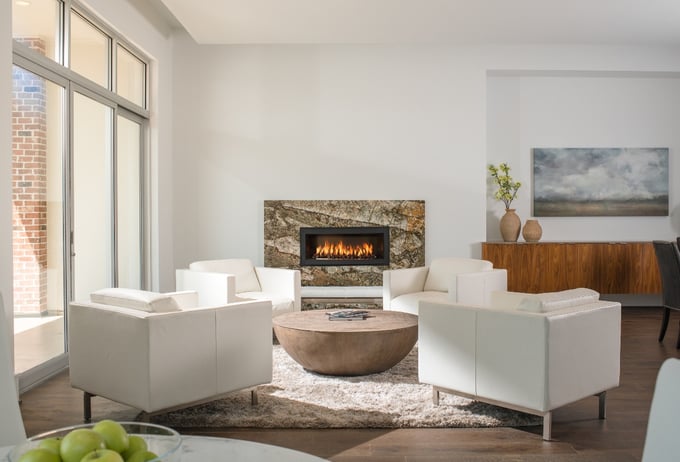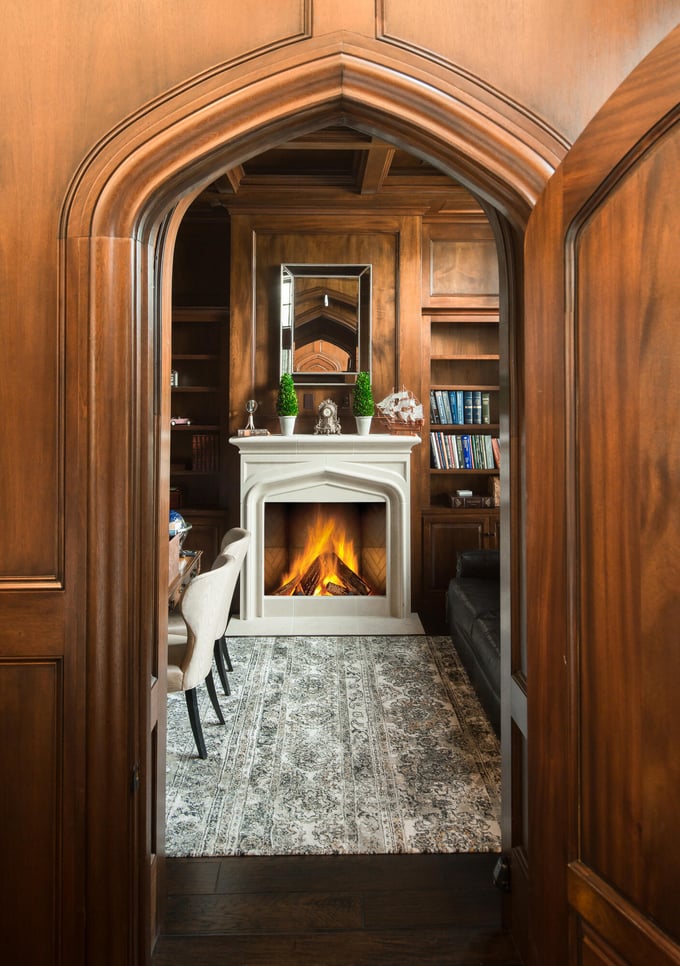
According to the National Association of Home Builders’ annual builder and buyer surveys, the desirability of fireplaces in single-family homes has been on the decline since 2015. Although that seems to be the national trend, that doesn’t seem to be the case for homeowners of high-end custom homes in Houston. We’ve actually never built a home WITHOUT a fireplace because 100% of our homeowners have desired one in their home. Their reasons are plenty, with ambience, resale value, and even hanging Christmas stockings among them.
For our homeowners, the decision is not whether to choose a fireplace at all, it’s actually whether to choose a WOOD-BURNING or GAS fireplace, or a combination gas AND wood-burning fireplace . With that in mind, today we’re going to dig into the pros and cons of both of these options, based on the categories of: Convenience, Cleaning & Maintenance, Appearance, Cost, and Efficiency.

CONVENIENCE
Gas fireplaces beat wood-burning fireplaces when it comes to ease of operation.
To start a wood burning fireplace, there’s a lot that has to be prepared:
- A 1 to 2-inch bed of ashes should be placed or kept in the bottom of the fireplace
- Any blockages need to be removed from the chimney to avoid smoke in home
- The damper must be opened
- The flue must be primed
- Firewood must be collected and strategically placed in the fireplace
- Plenty of wood must be stored close by to keep the fire going
Even after the fire has died out, you have to continue monitoring the wood burning fireplace for some time because a fire can start from a hidden ember.
To start a gas fireplace, you simply check for any debris, open the damper, and then either turn on the ignition switch or open the gas valve slightly and light with a small flame. To turn off, simply close the gas valve and the damper.
CLEANING & MAINTENANCE
Gas fireplaces take the win on this category as well, as wood burning fireplaces require quite a bit of maintenance. After each use, you have to clean out the soot and remove ashes and unburnt logs. In addition, you have to regularly monitor creosote buildup within the chimney or risk a potential flue fire. At the end of winter, you also need to have the chimney cleaned and inspected by a professional maintenance subcontractor. They will check the chimney inside and out for cracks that can allow smoke to enter the home or overheat the chimney components; either of which would create a fire hazard.
With gas fireplaces, the only maintenance that is needed is to have the vent pipe inspected yearly to ensure there is no buildup of debris and no valves or connections are leaking. There is a possibility that the thermopile and thermocouple may need cleaning, but very rarely.
APPEARANCE
When it comes to appearance, a wood burning fireplace ekes out the win because it provides an entire sensory experience! It not only looks homey and adds character to a space, but it provides the sound and smell of a “real” fire.
Although, it should be mentioned that gas fireplaces have come a long way in recent years, with variable height adjustment and ceramic logs that mimic actual firewood.
COST
For the initial construction of the fireplace, a wood burning fireplace is more expensive than a gas fireplace after factoring in all labor and materials (including a gas line and hookup).
Another consideration is the cost of using the fireplace. A cord of wood can cost several hundred dollars, depending on your location and the type and condition of the wood. On the flipside, a gas fireplace increases your monthly gas bill, although natural gas is relatively inexpensive.
As far as resale is concerned, any functioning fireplace in the home adds value, no matter which type it is.
EFFICIENCY
Gas fireplaces are the higher performer when it comes to heating efficiency. Traditional wood burning fireplaces are inefficient for heating a space, with only a 10%-15% heat efficiency rating compared to a 50%-90% rating for gas fireplaces (50% for a one-pipe vent fireplace, 70% for two-pipe vent fireplace, and 90% for a direct-vent fireplace). Both wood and gas fireplaces lose heat up the chimney, although wood burning tend to lose more. The rising hot air then creates a draft that pulls warm air from the room and other parts of the house right up the chimney with it.
On a related note, gas-fueled fireplaces are also more environmentally friendly because they emit 99% fewer particles than wood burning fireplaces, according to the EPA.
For each of the reasons shared above, all of our homeowners opt for a gas fireplace OR a combination gas AND wood burning fireplace for their home. It’s tough to beat the convenience and efficiency of a gas fireplace!